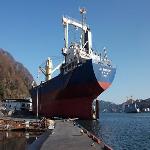March 19, 2011

Photo: VOA - H. Ridgwell
The 6,000-ton 'Asia Symphony' was washed onto the Kamaishi docks by the tsunami
Japan's prime minister has vowed to "rebuild the nation from scratch" as estimates of the cost of last week's earthquake and tsunami reach upward of $120 billion. The massive wave wiped out a whole swathe of coastline, taking with it factories, farms, roads, railways, houses and thousands of victims.
The devastated port of Kamaishi in Iwate prefecture has a long history of rising from the ashes of disaster. Henry Ridgwell visited the town, and found hope amid the wreckage and the reconstruction effort underway there.
The 6,000-ton freighter Asia Symphony lies beached on the docks at Kamaishi. The tsunami lifted her over the harbor and into the town. The looming bow of this huge vessel now sits within touching distance of a quayside house.
The surreal presence has become a symbol of the damage inflicted on Kamaishi. Along with the estimated 450 residents killed, the tsunami has ripped the industrial heart from this busy port.
Wandering among the twisted remains of the dockyard is construction worker Mazakatsu Sano. He says everything still feels unreal, like a dream.
Sano says it will take at least a year to reconstruct this place. He says everything - water, gas, electricity - will have to be re-built from scratch.
Looming over the port lies the Nippon Steel factory. It is a major employer in town and makes a large percentage of the world's steel wires and rods for vehicle tires and bridges. The plant's monthly output of 60,000 tons has been cut to zero.
Taking a walk through their devastated hometown are old friends Ayako Ito and Sei Obara. At 84 and 82 years old, respectively, they remember when Kamaishi became a target for Allied warships during World War II, because of its important steelworks. "The warships out in the bay fired shells 300 meters inland," said Ito. "It was terrifying!"
Ito says when the shells were fired, many people hid behind a huge wooden shelter. But a bomb landed behind it, and many people died. She says it still shocks her. She says every day people put rice and beans in their bags so they had food in case their homes were destroyed.
Sei Obara remembers the war, and is optimistic that Japan will again recover. "If we got through that," he says, "we can get through this. We will work hard, we will fight!"
The warships now anchored off Kamaishi carry Japan's own self-defense forces, which are using the town as a base for relief efforts.
Downtown Kamaishi is a wasteland, it's streets lined with the former fixtures of normal life. The clock in the town square is twisted and contorted out of shape. Hundreds of cars are crumpled in the rubble. The contents of a children's toy store are broken and strewn across the street. All will soon be carted away in the endless stream of dump trucks that throw up clouds of choking dust.
In their midst, disoriented survivors, a steady trickle of tsunami refugees, wander through the wreckage.
The economic impact will be felt hardest by the estimated half a million homeless. People like Isao Nozawa and his family, who are searching the remains of their wrecked house. It was lifted off its foundations - and now sits on top of the family car. "I am not insured for this," he says. "I did not take out tsunami or earthquake insurance because it is too expensive."
Back at the docks, Mazakatsu Sano looks out across the landscape that has been his lifelong workplace. "Maybe all the reconstruction work will provide us with jobs," he says, adding, "maybe."
The tsunami has wrecked Kamaishi. But the survivors insist that soon the now silent cranes and warehouses will once more ring out with the sound of industry.